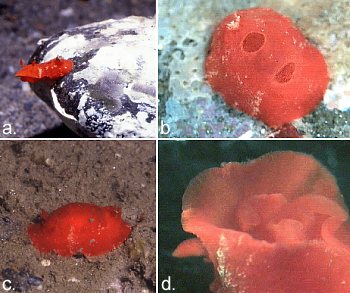
Aldisa smaragdina
Ortea, Perez & Llera, 1982
Order: NUDIBRANCHIA
Suborder: DORIDINA
Superfamily: EUDORIDOIDEA
Family: Dorididae
DISTRIBUTION
Mediterranean and nearby Atlantic coasts
PHOTO
A, Specimen 18 mm long alive. Cantarriján, Almuñecar, Granada, Spain. Depth 5m. 14 June 2002. B, Specimen 5 mm long alive. Cantarriján, Almuñecar, Granada, Spain. Depth 5m. 3 March 1999. C, Specimen 20 mm long alive. Velilla, Almuñecar, Granada, Spain. Depth 9m. 14 October 1996. D, Underside of anterior end showing flattened triangular oral tentacles. Photos: Luis Sanchez Tocino.
There seems to be some confusion in the identity of the species of Aldisa from the Mediterranean and surrounding seas. There seem to be at least two red species with two darker spots on the back, and white transverse marks across the mantle.
•Aldisa banyulensis Pruvot-Fol 1951 is said to have 8 gills and feeds on Hemymicale columella. It is small growing 8-12mm long
•Aldisa smaragdina Ortea, Perez, Llera 1982] grows to 30mm long and feeds on Anchinoe fictitius.
There is a third species, with very similar colour pattern, Aldisa expleta Ortea, Perez & Llera, 1982, but it lacks the two median dark spots on the dorsum. In the most recent revision of the genus, Millen & Gosliner (1985) say the situation is very confused and I can only agree. They consider Aldisa smaragdina to be a synonym of the earlier Aldisa binotata Pruvot-Fol, 1953. One problem is that A. binotata was poorly described, with no information on its anatomy. The single specimen on which the species is based is lost, so cannot be re-examined. The name Aldisa smaragdina continues to be used by European workers, presumably because there is no consensus on whether A. binotata is recognisable.
A. smaragdina, like A. banyulensis is red or orange-red with some white streaks on the mantle skirt. The mantle is pustulose and there are two darker pits in the dorsal midline between the gills and the rhinophores. The two differ in a number of external features. The rhinophores in A. smaragdina have few lamellae and they are arranged almost vertically while in A. banyulensis the more numerous lamellae are arranged horizontally. The gills in A. smaragdina are whitish in the upper half and red basally while in A. banyulensis they are a translucent red with no major white pigmentation. The rhinophore pockets in A. smaragdina have a series of tubercles around the edge and the gill pocket is strongly crenulate. In comparision, the edges of these pockets in A. banyulensis are smooth. Another more difficult difference to see is the shape of the head. In A. smaragdina the oral tentacles are slightly enrolled and bluntly cut off at the end, while in A. banyulensis they are triangular and flattened, with a pointed end. Both species have red eggs but they are larger [200µm diam] in A. banyulensis than in A. smaragdina [130µm].
References:
• Garcia, F.J., Garcia-Gomez, J.C. & Cervera, J.L. (1986) Ridescrizione di Aldisa banyulensis Pruvot-Fol, 1951 (Mollusca: Gastropoda: Nudibranchia). Lavori della Societe Italiana di Malacologia, 22: 97-110.
• Millen, S.V. & Gosliner, T.M. (1985) Four new species of dorid nudibranchs belonging to the genus Aldisa (Mollusca: Opisthobranchia), with a revision of the genus. Zoological Journal of the Linnean Society, 84: 195-233.
• Ortea, J.A., Perez, J.M. & Llera, E.M. (1982) Moluscos opistobranquios recolectados durante el plan de bentos circuncanario. Doridacea: primera parte (1). Cuadernos del Crinas, 3: 1-48.
• Pruvot-Fol, A. (1951) Etudes des nudibranches de la Mediterranee. 2. Arch. Zool. Exp. Gen., 88(1): 1-8O. (Pls. 14)
• Pruvot-Fol, A. (1953) Etude de quelques opisthobranches de la cote Atlantique du Maroc et du Senegal. Travaux de l'Institute Scientifique Cherifien, Zoologie, 5: 1-105. (Pls. 1-3)
Rudman, W.B., 2002 (November 11) Aldisa smaragdina Ortea, Perez & Llera, 1982. [In] Sea Slug Forum. Australian Museum, Sydney. Available from http://www.seaslugforum.net/factsheet/aldismar
Related messages
-
Aldisa smaragdina from southern Portugal
From: Carlos Afonso, June 26, 2006 -
Aldisa smaragdina - radular morphology
From: Luis Sanchez Tocino, November 20, 2002 -
Aldisa smaragdina - mantle spicules & penial spines
From: L. S. Tocino, November 20, 2002 -
Aldisa smaragdina from Spain (1)
From: Luis Sanchez Tocino, November 13, 2002 -
Aldisa smaragdina from Spain (2)
From: Luis Sanchez Tocino, November 13, 2002 -
Re: Aldisa? from the Canary Islands
From: Erwin Koehler, May 24, 2001 -
Aldisa? from the Canary Islands
From: Erwin Koehler, March 30, 2001
